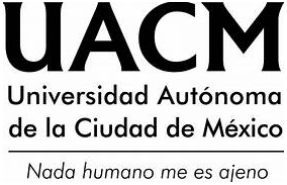AN EMERGING THOUGHT ON CONTEMPORARY ART
DOI:
https://doi.org/10.29092/uacm.v6i12.143Keywords:
Stencil, net.art, postmodernity, event, possibilityAbstract
This paper tries to configure an emerging thought on current reflexivity about art. In order to do so, stencil and net.art are analyzed as eminently self-critical expressive ways. This essay gathers some theoretical aspects about current thinking on art. It is mainly based on the aesthetic theories of Gilles Deleuze and Felix Guattari in What is Philosophy?, although it points out multiple issues concerning postmodern thought. The two artistic forms analyzed in this work —reflection of the same theoretical thinking that was collapsed by postmodernity— are seen as culminating moments within the emerging thought that requests aesthetics. They are brought out as the few revolutionary ways 376 Andamios ABSTRACTS that still allow for the development of a theoretical thinking at the edge of the institutional canons. Therefore, the two spaces (under the temporal irruptive denomination of the event) are offered as a construct of possibility in our contemporarity.
Downloads
References
BARTHES, R. (2000), Crítica y verdad. México: Siglo XXI.
BAUDRILLARD, J. (2006), El complot del arte: ilusión y desilusión estéticas. Buenos Aires: Amorrortu.
____________ (2007), El sistema de los objetos. México: Siglo XXI.
BENJAMIN, W. (1971), “El surrealismo: la última instantánea de la inteligencia europea” en Iluminaciones I. Madrid: Taurus.
____________ (2003), La obra de arte en la época de su reproductibilidad técnica. México: Ítaca.
BLANCHOT, M. (1976), “El museo, el arte y el tiempo” en La risa de los dioses. Madrid: Taurus.
____________ (1994), El paso (no) más allá. Barcelona: Paidós.
____________ (2000), El espacio literario. Barcelona: Paidós.
BREA, J. L. (2002), La era postmedia: acción comunicativa, prácticas artísticas y dispositivos. Salamanca: Consorcio Salamanca.
DELEUZE, G. (2002), Francis Bacon: lógica de la sensación. Madrid: Libros de Arena. ____________,
GUATTARI, F. (2001), Kafka: por una literatura menor. México: Era. ____________,
____________ (2005), ¿Qué es la filosofía?. Barcelona: Anagrama.
DIOCARETZ, M. (2006), “Interactivity and the Information Society Technological Imaginary” en Poética, núm. 27, primavera. México: UNAM, pp. 115-141.
FRISCH, V., SHIPLEY, J. T. (1945), Rodin. Buenos Aires: Poseidón. GARCÍA ALEJOS, J. (2006) “Identidad y alteridad en Bajtín” en Poética, núm. 27, primavera. México: UNAM. pp. 45-63.
HEGEL, G.W. F. (1971), Introducción a la estética. Barcelona: Barral Editores.
KANDINSKY, W. (1972), De lo espiritual en el arte. Barcelona: Barral-Labor.
NIETZSCHE, F. (2000), El nacimiento de la tragedia. Madrid: Alianza. ORTEGA Y GASSET, J. (1992), “La deshumanización del arte” en La deshumanización del arte. Velázquez, Goya. México: Porrúa.
ZERZAN, J. (2007), “Contra el arte” en Huso Crítico, núm. 3, otoño. Mé- xico: Centro Universitario de los Lagos y Universidad de Guadalajara, pp. 41-49.
ZOURABICHBILLI, F. (2004), Deleuze: una filosofía del acontecimiento. Buenos Aires: Amorrortu.
Published
Issue
Section
License
This Journal is licensed under Creative Commons Mexico 2.5. It is allowed to reproduce and disseminate the contents of the Journal for educational or research purposes, not for profit, as long as they are not mutilated and cite the source (Andamios, Revista de Investigación Social) and the author.
The copyright of the articles published in Andamios, Revista de Investigación Social are transferred by the author(s) to Universidad Autónoma de la Ciudad de México when the originals have been accepted, so that they are published and distributed both in the printed and electronic versions of the Journal. However, as established by law, the author(s) retains their moral rights. The author(s) will receive a form of assignment of copyright that they must to sign when their original has been accepted. In the case of collective articles, the signature of one of the authors will suffice, provided that the latter has obtained the consent of the others.
Authors may use the material of their article in other works or books published by themselves, with the condition of quoting Andamios as the original source of the texts.
The articles contained in this publication are the responsibility of their authors and do not compromise the official position of Andamios, Revista de Investigación Social of the Universidad Autónoma de la Ciudad de México.


